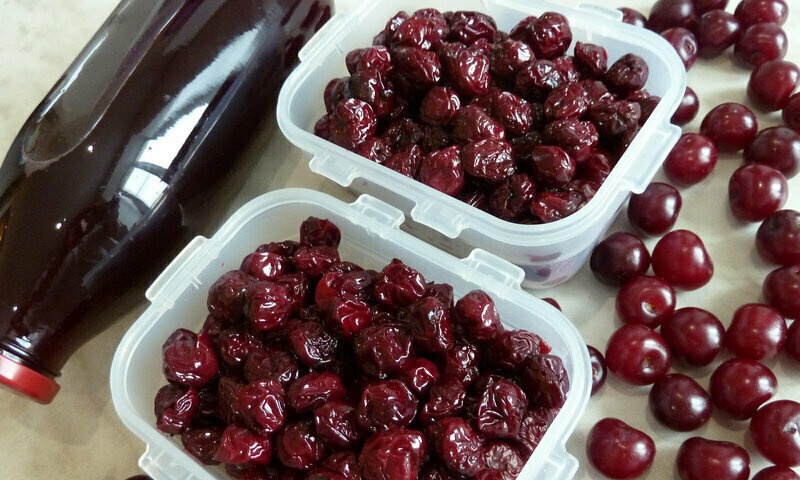20. How does the acidity of the sourdough affect the crumb structure in rye bread?
A decrease in the pH of the medium, an increase in titratable acidity - the stickiness decreases (less dextrins) due to a decrease (inactivation) of α-amylase of rye flour.
21. Is the slight stickiness of the crumb related to the insufficient acidity of the starter?
Yes, directly. See # 20.
22. Can you tell by taste whether the leaven has reached the required acidity?
Professionals can. The main setting of the organ of taste is the tongue. For everyone, taste is subjective. The sour taste is different for everyone, the sensations are different. Try the sourdough - bake - see the finished product, happy or not. Objectively - determination of titratable or active acidity.
23. What, in the opinion of experts, may be the point, it seems to me, of a strong fermentation of fermented tea leaves (18-20 or 20-24 hours !!! in a warm place) in a whole galaxy of folk Lithuanian recipes for rye custard bread, published in the book "Lietuviųvalgiai" (Lithuanian cuisine)?
There is a sense, since at elevated temperatures and for a long time there (in the brew) thermophilic lactic acid bacteria develop, mainly of the genus L. delbrueckii, giving a specific pleasant smell to the fermented brew. The final acidity and the amount of aromatic substances depend on the duration.
24. Acquired chemicals for titration. I would like to measure the acidity of bread. GOST 5670-96 considers a method for determining the acidity of bakery products. The collection often indicates the acidity of the leaven! The question is how to determine the acidity of the starter culture? In the same way as in GOST 5670-96? What is the weight of the sample?
5 gr. starter cultures and 50 ml. water.
25. Is it permissible to use liquid starter cultures in those recipes where thick leaven is required and how does the moisture of the leaven affect the taste of bread?
Supposedly, it is necessary to focus on the titratable acidity of the bread, that is, the dosage of liquid sourdough instead of the thick one should provide the necessary acidity, non-crease and no crumb stickiness.
26. How critical is it that during refreshing I overfeed the starter at a different moisture content of 72% (200% bakery) -> 57% (100% bakery)?
See # 8.16
The content of yeast decreases, acidity increases under equal conditions - temperature, duration of fermentation.
27. How does its moisture affect the baking quality of the sourdough? Thick and liquid starter cultures, what is the fundamental difference?
See # 8,16,26
28. What is the best preservation method for a home baker?
Refrigerated storage (+ 2- + 6) or fermentation with plenty of food, or both. It's up to the baker to decide. The quality indicators of the starter culture change in any case.
29. Does the sourdough subject to multiple cycles of conservation-de-conservation change its properties?
They change, even with a single dose. Discreteness of management - stress for microorganisms, introduction of a new "batch" of microorganisms with nutrition - competition, displacement, change in properties.
30. Does the leaven have a finite life, after which its original properties are irrevocably lost?
From several days to 2-4 weeks.
31. Can you give a single recommendation to home bakers about the recommended period of using the spontaneously fermented rye sourdough, after which it should be thrown away and a new one removed?
A new batch of flour is a new leaven. It's up to the baker to decide. If you are satisfied, use.
32. I store refreshed and chilled starter culture (flour, water 1: 1) at 4-6C. At this temperature, the processes of vital activity of the microflora do not stop, they proceed at a slower pace, and even after 30 days of storage, the leaven is easily "revived" by a series of refreshments.Is there a contradiction in this method with your ideas about preservation and storage in the cold, or does this approach have a right to exist?
If you are satisfied - use, See # 19. Depending on the species composition of the starter culture, the properties can change - either an increase in acidity (the predominance of mesophilic MCD) with suppression of yeast, or an increase in alcoholic fermentation (yeast competing with MCB). An objective assessment of the quality indicators of the starter culture is required. For each (from one batch of flour) spontaneous leaven everything is very individual. Don't predict.
Long question from a reader:
- Hello! Quote from the "Collection of technological instructions for the production of bakery products":
"Preservation of liquid sourdough * without brewing ....
If it is necessary to preserve the liquid starter culture for 10-15 days, a small amount of it (5-10 kg) is placed in a refrigerator with a temperature of 4-6 ° C.
To resume the fermentation process, the cooled sourdough is refreshed with a nutrient mixture in a 1: 1 ratio with an initial temperature of 28-30 ° C and then accumulated to the required amount by refreshing according to the recipe and the technological mode of the production cycle. "
* Liquid sourdough - a sourdough with a moisture content of 72% (about 200% baker's).
Questions:
33. How long can you keep the leaven in the refrigerator so that it does not lose its qualities?
No more than 10-15 days.
34. Is it possible to preserve starter culture of other moisture content, for example, 57% (100% baker's) or 50% (71% baker's) for such a long period of 10-15 days?
You can't.
35. The collection says that 50% thick leaven (71% of baker's) can be preserved for a maximum of 24 hours.
24-48 hours.
36. The quality of rye (wheat-rye) bread 30 years ago was much better, in other words, the bread tasted better. Even now, the same varieties of rye-wheat bread made at different bakeries are very different. Is it related to different leavens or is it the result of a violation of technology? (Moscow).
If the technology is followed using starter cultures on pure cultures, the quality should be the same and the same as 30 years ago. The question of the quality of the flour used is a question for the millers.
37. How important is it when maintaining the starter cultures, the exact observance of the temperature regime at home, that is, when we are not very limited in time, as in production?
All microorganisms have their optimum development - temperature, pH, the presence of growth factors, etc. Temperature is a very important parameter and its change directly leads to a change in the ratio between microorganisms, in connection with which the quality of the starter changes.
38. How does the addition of cultured yeast affect the quality of bread made with sourdough (often a scanty amount of yeast is introduced in recipes for sourdough bread)? Or is it just a necessity for production when meeting a schedule is important? Does not using yeast in homemade sourdough bread compromise the quality of the bread?
The introduction of compressed yeast into the dough affects the looseness of the crumb of bread, therefore, it is more loosened on the taste perception. Organoleptically nicer than loose.
39. Why can leaven lose its lifting power?
Due to the death of yeast - increased acidity, temperature.
40. In industry, sourdoughs are specially used to protect bread from potato and chalk disease, mold and miraculous sticks. That is, the presence of certain microorganisms in the leaven is guaranteed.
Do home bakers have the ability to maintain a leaven that protects the bread after baking? That is, what can be done so that when the ferments are removed, these microorganisms, for example, propionic acid MCB, are present there and do not disappear from there when the ferment is introduced.
What for? Potato disease, chalky, mold can occur 72 hours after baking. Do not store for so long, eat fresh. Propionic acid bacteria do not develop in a water-flour suspension - no pit. substances and growth factors.
41. and, probably, the second question, if possible ...Are there tables or graphs for recalculating TTA for the pH of dough dough, sourdoughs and bread (titratable acidity, as in GOSTs, for active acidity, which can be measured with a pH meter or litmus paper). Or are there any alternative ways to find out if, during the fermentation process, the sourdough / dough / dough has reached the acidity specified in GOSTs without titration with alkali?
They exist, but they do not correlate 100% with the titrated one, because the pH depends on the buffer capacity of the medium, and the composition (ratio) of the acids produced - for a thick consistency, some values, for a liquid - others. Titratable acidity is the easiest way to control quality in production, nothing could be simpler. Portable pH meter only.
42. In Soviet times, an instruction was approved for determining the relationship between titratable and active acidity, in addition, a table of the relationship between these values. For the first time, such a table was made as an appendix to a pH meter produced by the Gomel Plant of Measuring Instruments. Here is a snippet from this table:
- "active acidity of" Sliced loaf "made of 1st grade wheat flour weighing 0.4 kg = pH 5.63, titratable acidity = 3º.
See # 41. It is necessary to compare (calibrate) the pH meter depending on the titratable acidity. Titrated is a more accurate indicator.
What microflora is present in the leaven that does NOT spontaneously ferment according to the Hugo Herbe system and which strains dominate there?
Which pure cultures have contributed and dominated. If you have introduced microorganisms not specific for this (water-flour) environment, they will be replaced by endogenous flour microorganisms.
A popular question and topic on the Internet about "killer yeast" that yeast is supposedly Hitler's secret weapon to destroy the population of Russia.
I would like to hear the opinion of a professional about the popular legend of "killer yeast". And the questions are:
43. Bread based on cultured yeast is harmful, but on leaven it is healthy - is it true?
No. Yeast is the same everywhere - the species Saccharomyces cerevisiae. The sourdough may contain other yeasts.
44. Which bread will be healthier, spontaneously fermented sourdough bread or store-bought yeast bread?
Spontaneous leavened bread may not meet the requirements of the standards and contain unknown (including harmful metabolic products, depending on the leaven) metabolites. Compressed yeast bread is safe.
45. Does yeast die during baking? Do these thermophiles live in nature or is it a specially bred yeast? Are these thermophiles GMO or not GMO? Is there generally yeast-free bread (I mean not unleavened bread, but in which fermentation is provided)?
Dying !!!
Thermophilic exist. Why are they called that? It's just that their temperature optimum is 38-45 ° C, with an increase to 60-65 degrees. they die. The cell wall cannot withstand temperatures.
There is no such thing as yeast-free bread, it is made “without using pressed yeast”. When making bread without using compressed yeast, yeast comes in with flour, sourdough and develops during dough fermentation.








